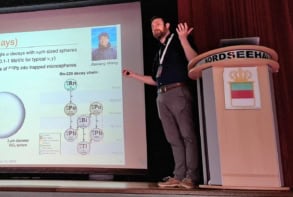A physicist in the US has analysed radio waves from distant galaxies to obtain a new upper bound on the electrical charge of the photon. Brett Altschul of Indiana University has found that the charge is no more than 10-46 times the charge of the electron -- assuming the existence of photons with positive and negative charges. This is 13 orders of magnitude better than the previous direct bound on the charge of a particle that we normally assume to be neutral (Phys. Rev. Lett. 98 261801).
The possibility that the photon has a charge would have profound implications on a wide range of physics. For example, charged photons in the dense early universe would have had a tremendous amount of electrical potential energy, which does not fit in with our understanding of how the universe has evolved.
Furthermore, our current understanding of elementary particles suggests that a charged photon would imply the existence of an oppositely-charged anti-photon — but if such particles existed, much of the everyday physics that we take for granted would be different.
To place a bound on the photon’s charge, Altschul looked at data from the VSOP experiment – which operated from 1997 to 2005 using a combination of earthbound telescopes and the HALCA space telescope to study radio waves from distant galaxies. Signals coming from the same source were detected by separate telescopes and the interference between the signals was measured. By taking successive measurements VSOP was able to build up images of very distant galaxies that could not be resolved using a single telescope.
However, VSOP will only work if the photons detected at each telescope are coherent – and this coherence would be degraded if the photon has even the smallest electric charge. This is because photons detected at different telescopes would have travelled through slightly different magnetic fields, causing the relative phases of charged photons to change and destroying their coherence.
Altschul was unable to find any evidence of decoherence in VSOP data from galaxies about 1bn parsecs (about 3 bn light years) away, allowing him to conclude that the charge on the photon is less than about 10-32e.
He then put an even more stringent limit on the charge by assuming the existence of anti-photons. Quantum mechanics does not allow different particles –photons and anti-photons, for example – to interfere with each other. By bending the rules to allow such particles with tiny charges to interfere, Altschul was able to estimate how coherence would be lost by photons and anti-photons travelling long distances.
He concluded that the charge on the photon and anti-photon is less than about 10-46e. This is thirteen orders of magnitude better than the previous estimate for photons of two opposite charges, which had been done by looking for a “blurring” of the radio images of distant galaxies.



